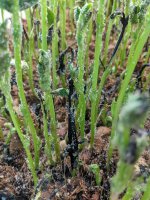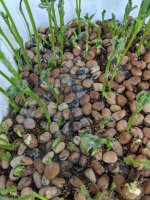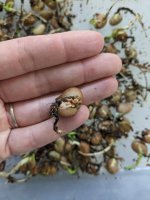Hi all,
An extremely brief intro - entomologist from QLD in Aus, desperate for advice. I have a persistent issue of blackening/necrosis on faba beans that I am growing for use in insect cultures. I have little experience in horticulture and have struggled to find solutions online. Bean seeds are nasma variety, soaked for 24 hr and then planted into fairly sterile media. Temperature 24C, RH 50-60%, grown under LEDs at 4000k (colour temp). Blackening occurs within a few days of germination. Originally I thought it was overwatering, so I reduced watering to every 12 hrs (down from every 8 hrs), and it didn't seem to help much.
I know that I will not get optimum growth from these faba beans since I am limiting their nutrients by growing in almost sterile media (vermiculite and some peat). I have seen that they grow much better in media supplemented with potting mix. However, I have successfully grown the beans without supplementation and no blackening on a few occasions and not sure what I was doing differently. Please disregard the aphids in some photos, the blackening occurs without aphid infestation as well.
I'd like to break it down and make sure I am doing the basics correctly. I want to avoid adding too many things into the mix as some of our insects are incredibly sensitive to chemicals, even fertilisers. Any advice/questions will be appreciated. Thanks!
An extremely brief intro - entomologist from QLD in Aus, desperate for advice. I have a persistent issue of blackening/necrosis on faba beans that I am growing for use in insect cultures. I have little experience in horticulture and have struggled to find solutions online. Bean seeds are nasma variety, soaked for 24 hr and then planted into fairly sterile media. Temperature 24C, RH 50-60%, grown under LEDs at 4000k (colour temp). Blackening occurs within a few days of germination. Originally I thought it was overwatering, so I reduced watering to every 12 hrs (down from every 8 hrs), and it didn't seem to help much.
I know that I will not get optimum growth from these faba beans since I am limiting their nutrients by growing in almost sterile media (vermiculite and some peat). I have seen that they grow much better in media supplemented with potting mix. However, I have successfully grown the beans without supplementation and no blackening on a few occasions and not sure what I was doing differently. Please disregard the aphids in some photos, the blackening occurs without aphid infestation as well.
I'd like to break it down and make sure I am doing the basics correctly. I want to avoid adding too many things into the mix as some of our insects are incredibly sensitive to chemicals, even fertilisers. Any advice/questions will be appreciated. Thanks!





